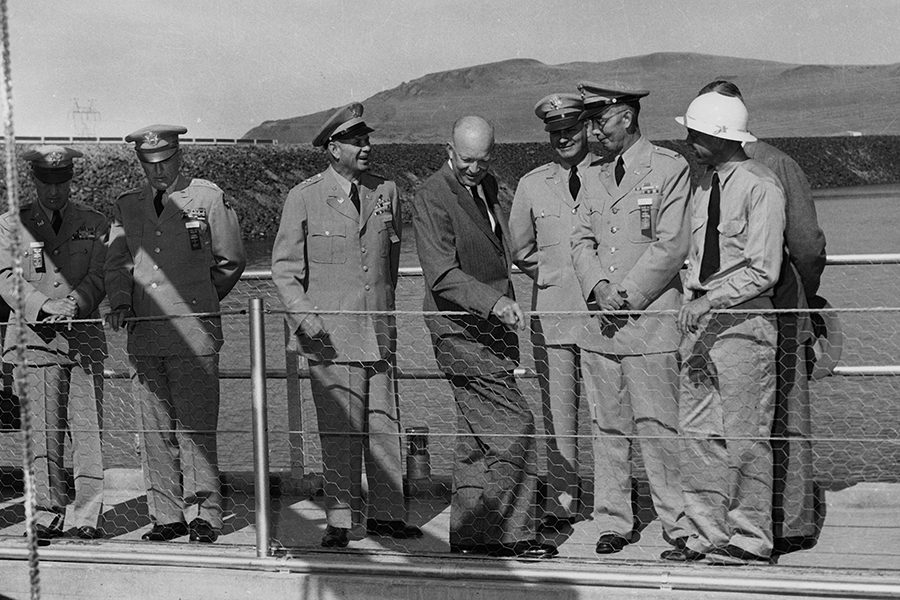
Home » Eisenhower dedicated McNary Dam 66 years ago this month, called water a ‘natural legacy’
Eisenhower dedicated McNary Dam 66 years ago this month, called water a ‘natural legacy’

September 25, 2020
By East Benton County Historical Society
It was a no school day on Sept. 23, 1954, in east Benton County and surrounding areas.
The bright, beautiful, sunny early autumn day remained, however, a day of education and history.
Students from grade school up didn’t get a day’s learning at their desks carved with inkwells and pencil canals. They didn’t solve a problem in long division. They didn’t dissect a sentence on the blackboard, identifying pronouns, verbs and adjectives.
It was an education derived at a structure comprising 1.8 million cubic yards of concrete.
It was the dedication of McNary Dam 66 years ago this month on the Columbia River near the little east Benton County community of Plymouth, and 30,000 were on hand to see it, and hear the remarks of the man dedicating McNary, Dwight D. Eisenhower, the 34th president of the United States.
For many, it was a once-in-a-lifetime chance to see their president up close.
Local participation was not lacking.
The Richland, Kennewick and Pasco high school bands, under their respective directors, Gordon W. Pappas, Hampton Wines and John J. Fitzpatrick, all performed. Hermiston High’s band under Ted Marshall, and Umatilla High’s under Robert M. Lennebille, also were part of entertainment, headlined by the Navy’s precision flying team, the Blue Angels.
The Tri-City Aqua Acrobats, under the late Dale Metz, longtime owner of Metz Marina on Clover Island, gave three water show performances.
Washington Gov. Arthur B. Langlie, Oregon Gov. Paul L. Patterson and Secretary of the Interior Douglas McKay also spoke. On the presidential dais were J. T. Bettinson, a Benton County commissioner, and J. M. Doyle of Plymouth.
Eisenhower awakened at the Marcus Whitman Hotel in Walla Walla where he spent the night in modest but comfortable accommodations that included an outer room to relax and host, and an adjoining bedroom and bathroom separated by a door.
His bedroom window, several stories up, looked south onto the city of Walla Walla, and his living room window looked east toward the Blue Mountains.
He traveled to McNary by car via Pendleton and it was said that the 55 miles he traveled to the dedication was (and perhaps still is) the longest presidential motorcade in history.
His address at the powerhouse still resonates.
“This structure symbolizes the purpose of using, for the benefit of all our people, the tremendous natural legacy with which the almighty so abundantly endowed our land,” Eisenhower said. “Wisely and providently we must use and develop these resources, so that each succeeding generation of Americans may share in their benefits.
“It is for us to see that they shall not be wasted or neglected or denied to generations yet to come.”
Water, he said, is a “blessing” when used properly.
“It is essential that every drop of water, from the moment that it falls upon our land, be turned to the service of our people,” the president said. “Thus we will save our soil and make it more productive; thus we will develop power, prevent floods, improve navigation and supply our tremendous and growing domestic and industrial water needs.”
Following his dedication address at 10:30 a.m. that Thursday, President Eisenhower returned by car to Pendleton where his plane “Columbine,” named by his wife Mamie, awaited. Air Force One became the official designation in 1962.
McNary Dam was named for Oregon Sen. Charles L. McNary, a 1940 Republican Party nominee for vice president of the United States and a well-liked 28-year member of the U.S. Senate. He died in 1944.
On April 15, 1947, Cornelia Morton McNary, his widow, turned the first earth in ground-breaking ceremonies. She was joined by Janis Paige, a well-known Warner Brothers actress in the 1940s and 1950s who was born in Tacoma. She was named “Miss Damsite.” Also attending was Oregon Gov. Earl Snell.
During Eisenhower’s dedication the late senator’s widow shared the platform where he paid personal tribute to her.
McNary Dam is 292 miles from the mouth of the Columbia River, 7,365 feet long and stands 183 feet over the riverbed. Its multiple purposes include hydroelectric power generation, irrigation, navigation, recreation and wildlife habitat, and it is one of 14 dams, including three in Canada, on the main stem of the Columbia.
McNary has two fish ladders for salmon and steelhead, one each on the Oregon side and the Washington side to aid salmon in reaching their spawning grounds. An 86-foot wide, 683-foot long navigation lock on the Benton County side can lift boats 75 feet, including tugs and barges navigating the river with cargo.
Extending behind McNary Dam is a reservoir named Lake Wallula extending 64 miles back to the Tri-Cities to Hanford and up the Snake River to Ice Harbor Dam.
Local News
KEYWORDS september 2020





